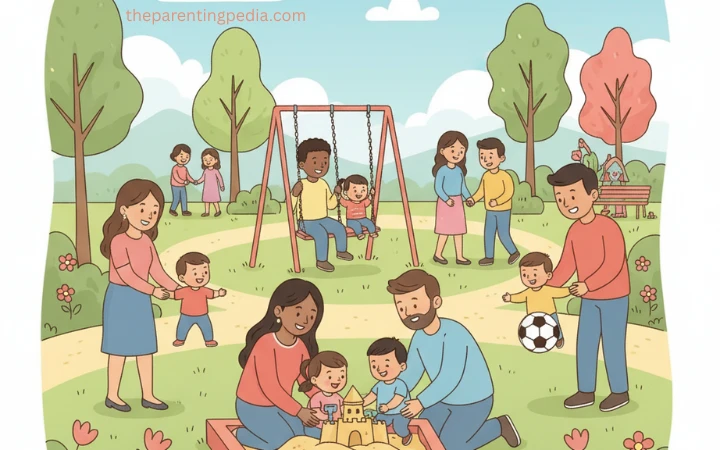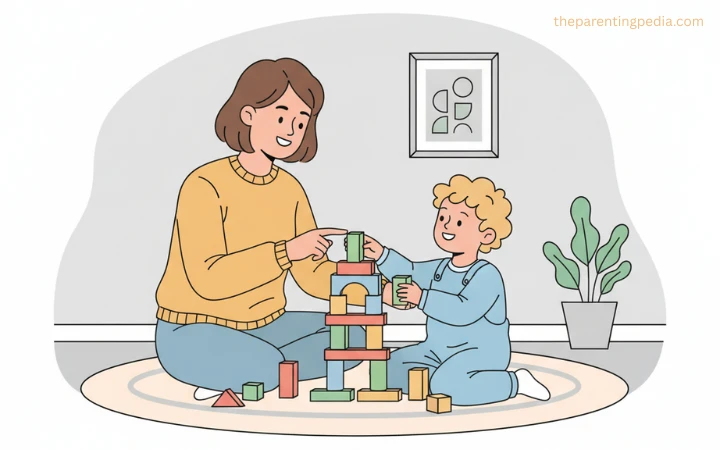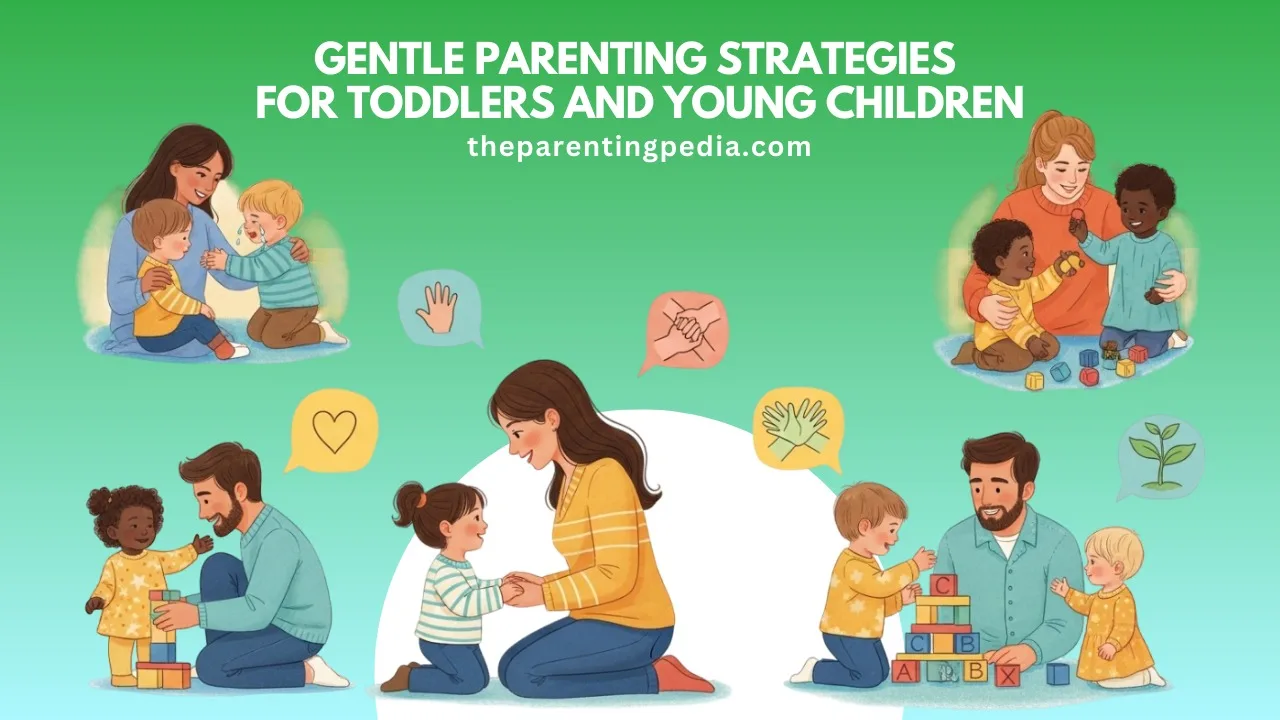Raising toddlers and young children is one of the most rewarding yet challenging experiences for parents. Children at this age are exploring the world, testing boundaries and learning how to express their emotions. For many parents, tolerating tantrums of children, power struggles and constant questions from them can feel overwhelming. Gentle parenting offers a nurturing approach that focuses on empathy, respect and connection, helping children develop confidence, emotional resilience and strong relationships with their parents.

What Is Gentle Parenting?
Gentle parenting is a parenting philosophy that emphasizes understanding, compassion and guidance rather than punishment. Instead of reacting to unwanted behavior with anger or force, parents practicing gentle parenting focus on teaching, modeling and helping children learn appropriate ways to express themselves. This approach prioritizes the emotional needs of children while still setting clear boundaries and expectations. Gentle parenting is not about being lenient or letting children do whatever they want. Rather, it is about guiding behavior with patience, empathy and respect, helping children develop self discipline and social skills naturally.
Benefits of Gentle Parenting
There are numerous benefits of gentle parenting for both children and parents. Children raised with gentle parenting are more likely to:
- Develop healthy emotional regulation and coping skills.
- Feel secure and supported, which builds self-esteem in children.
- Develop empathy and respect for others.
- Build stronger bonds with their parents, promoting trust and open communication.
Parents also benefit from reduced stress and more positive interactions with their children, creating a calmer and more supportive home environment.
📸➡️ “One click, one link — make your images shareable with Imagelink.online”
Building Strong Parent-Child Connections
A central aspect of gentle parenting is building a strong connection with children. Toddlers and young children need to feel loved and understood to develop confidence and emotional resilience. Parents can strengthen connections by:
- Spending quality time focused on the child without distractions.
- Listening actively to the child’s feelings and thoughts.
- Acknowledging emotions even when the behavior is challenging.
- Showing affection through hugs, praise and comforting words.
When children feel emotionally secure, they are more likely to cooperate, communicate and respond positively to guidance.

Encouraging Positive Behavior In Children
Instead of punishing children for misbehavior, gentle parenting encourages parents to focus on teaching and guiding, with positive reinforcement as a key strategy. Parents can praise effort and progress of children rather than just results, highlight good behavior by saying things like, “Thank you for sharing your toy” and redirecting children to appropriate alternatives instead of simply saying “no.” By focusing on teaching and reinforcement, children learn the reasons behind rules and develop internal motivation to behave appropriately.
Setting Boundaries with Empathy
Boundaries are essential in gentle parenting. Toddlers and young children need clear limits to feel safe, but these boundaries should be set with empathy and understanding. For example:
- Instead of saying, “Stop crying!” parents can say, “I see you are upset. Let’s take a deep breath together.”
- Instead of forcing bedtime, parents can create a calming routine that gently signals it is time to sleep.
- Consistent, empathetic boundaries help children feel secure while learning self control and respect for rules.
🎉 Score Freebies by Completing Fun Offers – Start Now!
Handling Tantrums Calmly
Tantrums are a normal part of toddler and early childhood development. Gentle parenting provides strategies for handling these moments calmly:
- Stay calm and composed, modeling emotional regulation to children.
- Acknowledge the child’s feelings by saying things like, “I know you are frustrated because you want the toy.”
- Offer comfort without giving in to unreasonable demands of children.
- Wait until the child is calmer to guide them toward problem solving.
Responding with empathy rather than anger teaches children that emotions are natural and manageable, helping them develop self consoling skills.
Promoting Independence In Children
Gentle parenting also emphasizes promoting independence in toddlers and young children. Encouraging children to try tasks on their own helps build confidence and problem solving skills. Parents can support independence by:
- Allowing children to dress themselves or choose snacks.
- Encouraging age appropriate responsibilities like tidying toys.
- Offering choices within safe limits.
- Letting children make mistakes and learn from them.
By gently guiding rather than controlling, parents help children develop self-reliance while still providing a safe, supportive environment.
🚀 “Upload. Get a link. Share anywhere — only on Imagelink.online”
Effective Communication in Gentle Parenting
Open, respectful communication is foundation of gentle parenting. Parents can model how to express feelings clearly and listen actively. Strategies include:
- Using “I” statements in front of children like “I feel concerned when toys are thrown because someone might get hurt.”
- Asking open-ended questions to encourage communication with children like “How do you feel about sharing your toy?”
- Listening without interrupting and validating the child’s emotions.
- Avoiding threats or shaming, which can damage trust and self esteem of children.
When children feel heard, they are more likely to express themselves constructively and develop strong communication skills.
Effective Gentle Discipline Techniques for Children
Gentle parenting offers alternative discipline techniques that teach rather than punish. These methods include:
- Time-ins: Time-ins involve sitting with the child during strong emotions to help them calm down and feel supported.
- Natural consequences: Natural consequences occur when parents allow children to experience the results of the safe choices they make, helping them understand the impact of their actions and learn from their decisions.
Also Read: Challenges of Parenting During Divorce and How to Overcome Them
- Redirection: Redirection involves guiding a child’s attention to a more appropriate activity to help them learn positive behavior.
- Problem Solving: Parents can encourage problem-solving together by asking their children, “What can we do next time to prevent this?” This approach helps children think critically about their actions and learn constructive ways to handle similar situations in the future.
These approaches help children understand the impact of their behavior while maintaining their sense of dignity and respect.
Supporting Emotional Development In Children
Gentle parenting nurtures emotional intelligence from an early age. Parents can help children recognize and manage emotions by:
- Labeling emotions means helping children name their feelings, for example, “You seem sad because your tower fell.”
- Encouraging expression in children through words, drawing or play.
- Modeling healthy coping strategies in front of children for frustration or disappointment.
- Providing reassurance and comfort during emotional moments.
Children who develop emotional awareness are better equipped to handle stress, build friendships and navigate social situations confidently.
🎁 Take Quick Offers, Grab Your Reward Instantly!
Challenges of Gentle Parenting
While gentle parenting has many benefits, it also comes with challenges. Parents may face:
- Feeling pressure from societal norms or family members to use stricter discipline.
- Struggling with consistency when tired or stressed.
- Balancing empathy with enforcing necessary rules.
Parents should remember that gentle parenting is a journey, not perfection. Patience, self-compassion and support from other caregivers can help parents stay committed to this approach.

Conclusion
Gentle parenting offers a compassionate, respectful and effective approach to raising toddlers and young children. By focusing on empathy, positive reinforcement, healthy boundaries and emotional support, parents help their children grow into confident, resilient, and emotionally intelligent individuals. Through consistent practice of gentle parenting strategies, parents create a nurturing environment where children feel safe, valued and understood. This approach strengthens the parent-child bond, reduces stress and lays the foundation for lifelong healthy relationships. By embracing gentle parenting, parents are not only guiding their children toward appropriate behavior but also teaching them essential life skills, emotional regulation and self-confidence that will serve them well throughout life.
FAQ
What is the concept of gentle parenting?
Gentle parenting is a nurturing approach that emphasizes empathy, respect and guidance instead of punishment. It focuses on understanding children’s emotions, setting consistent boundaries and teaching appropriate behavior through positive reinforcement. This approach promotes emotional intelligence, confidence and strong parent-child bonds while encouraging children to develop self-discipline and resilience.
What are the disadvantages of gentle parenting?
Gentle parenting can be challenging because it requires consistent patience, time and emotional energy from parents. Some may struggle with setting firm boundaries or feel pressured by others who favor stricter discipline. Inconsistency or fatigue can reduce effectiveness and children may test limits more requiring careful guidance and persistence.
What are the basics of gentle parenting?
Parents wanting to help their children grow to be loving and responsible adults can do no better than to remember the Parenting Golden Rule: “Treat your child as you would like to be treated if you were in the same position.” It’s simple, straightforward, and effective.
What’s the best parenting method?
The best parenting style is generally considered to be the authoritative style, which balances clear expectations and boundaries with warmth, support, and open communication. This “firm but nurturing” approach fosters self-regulation, responsibility, and high self-esteem in children, while also promoting good social skills and academic success.
What are the problems with gentle parenting?
Problems with gentle parenting include the risk of becoming permissive, leading to children who struggle with self-regulation and boundaries, and can also be overly child-centric, making parents feel pressured or inadequate. This approach can be unsustainable and lead to parental burnout, foster self-conscious or robotic parenting, and may create unrealistic expectations influenced by idealized social media portrayals.
Get inspired by simple yet powerful business opportunities you can explore now.
